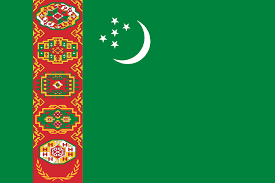Language/Turkmen/Vocabulary/Basic-Greetings
| Next Lesson — Introducing Yourself ▶️ |
Introduction[edit | edit source]
In this lesson, we will cover the basics of greetings in the Turkmen language. Greetings are an essential part of any language and culture, as they allow people to connect and show respect to one another. By learning basic greetings in Turkmen, you will be able to greet people and start conversations with confidence. This lesson is designed for complete beginners and is part of the larger course titled "Complete 0 to A1 Turkmen Course." By the end of this lesson, you will be able to greet others in Turkmen, introduce yourself, and respond to basic greetings.
Greetings in Turkmen[edit | edit source]
Turkmen, as a language, has a rich vocabulary of greetings that are used in various situations. Let's start by learning some of the most common greetings in Turkmen:
Hello[edit | edit source]
The most common way to say "hello" in Turkmen is "salam." It is a simple and friendly way to greet someone. You can use it in both formal and informal settings. Here are a few examples:
| Turkmen | Pronunciation | English |
|---|---|---|
| Salam | [sɑˈlɑm] | Hello |
| Salam, meniň adym John | [sɑˈlɑm mɛˈniŋ ɑˈdɯm ʤɔhn] | Hello, my name is John |
| Salam, nasyl ýaşarsyňyz? | [sɑˈlɑm nɑˈsɯl jaˈʃɑrsɯˈnɯz] | Hello, how are you? |
Goodbye[edit | edit source]
When saying goodbye in Turkmen, you can use "hoşça kal" or "sag bol." These phrases are commonly used to bid farewell to someone. Here are a few examples:
| Turkmen | Pronunciation | English |
|---|---|---|
| Hoşça kal | [hoʃˈtʃɑ kɑl] | Goodbye |
| Sag bol, men birazdan gelýärin. | [sɑˈɡ bɔl mɛn birɑzˈdɑn ɡɛˈlɯːˈɑrɯn] | Goodbye, I'll be back in a moment. |
| Hoşça kal, täzeden göräşýäris. | [hoʃˈtʃɑ kɑl tæˈzɛdɛn ɡœˈræʃˈjæris] | Goodbye, see you later. |
How are you?[edit | edit source]
In Turkmen, to ask someone how they are, you can use the phrase "näme edip durýansyň?" or simply "näme?" These phrases are commonly used in polite conversations to inquire about someone's well-being. Here are a few examples:
| Turkmen | Pronunciation | English |
|---|---|---|
| Näme edip durýansyň? | [næˈmɛ ɛˈdip dʊˈrjɑnˈsɯŋ] | How are you? |
| Näme? | [næˈmɛ] | How are you? |
| Hämmandan gowy, sag boluň! | [hæmˈmɑndɑn ɡɔˈwɯ sɑˈɡ bɔˈlɯŋ] | I'm fine, thank you! |
Cultural Insights[edit | edit source]
Greetings in Turkmen culture are often accompanied by various gestures and customs. One common practice is shaking hands, especially in formal settings or when meeting someone for the first time. It is customary to shake hands firmly while making eye contact. In more casual situations, friends and family members may greet each other with hugs or kisses on the cheek. It is important to note that Turkmen people value respect and politeness, so using appropriate greetings is highly appreciated.
Turkmenistan, a country in Central Asia, has a diverse cultural heritage. Its traditions and customs have been influenced by the nomadic lifestyle and the historical Silk Road trade route. The Turkmen people take pride in their hospitality and often go out of their way to make guests feel welcome. Greetings play a crucial role in establishing a positive connection and showing respect to others. By learning and using Turkmen greetings, you can engage in meaningful cultural exchanges and build strong relationships with Turkmen people.
Practice Exercise[edit | edit source]
Now it's time to practice what you've learned! Below are some scenarios where you can apply the greetings and introductions you've learned in this lesson. Choose the appropriate Turkmen phrases to respond to each situation.
Exercise 1[edit | edit source]
You meet a new colleague at work. They greet you by saying "Salam." How would you respond?
Solution: You can respond by saying "Salam" back to greet them or use the phrase "Salam, meniň adym [Your Name]." For example, if your name is John, you can say "Salam, meniň adym John."
Exercise 2[edit | edit source]
Your friend asks you "Näme edip durýansyň?" How would you reply?
Solution: You can reply by saying "Hämmandan gowy, sag boluň!" which means "I'm fine, thank you!"
Exercise 3[edit | edit source]
You are leaving a party and want to say goodbye to your friends. How would you bid farewell?
Solution: You can say "Hoşça kal" or "Sag bol" to say goodbye to your friends.
Conclusion[edit | edit source]
In this lesson, you have learned some basic greetings in Turkmen, including how to say hello, goodbye, and ask someone how they are. You have also gained insights into Turkmen culture and customs related to greetings. By practicing the exercises, you can apply your knowledge and build confidence in using these greetings in real-life situations. Keep practicing and expanding your Turkmen vocabulary to enhance your language skills. In the next lesson, we will learn how to introduce ourselves and ask for someone's name in Turkmen.
Videos[edit | edit source]
TURKMEN 20 BASIC WORDS | TÄZE NESIL - YouTube[edit | edit source]
Sources[edit | edit source]
Other Lessons[edit | edit source]
- Fruits
- Days of the Week
- Greetings
- Family
- Modes of Transportation
- Colors
- How to say Good Bye?
- Directions and Locations
- House
- Education
| Next Lesson — Introducing Yourself ▶️ |

